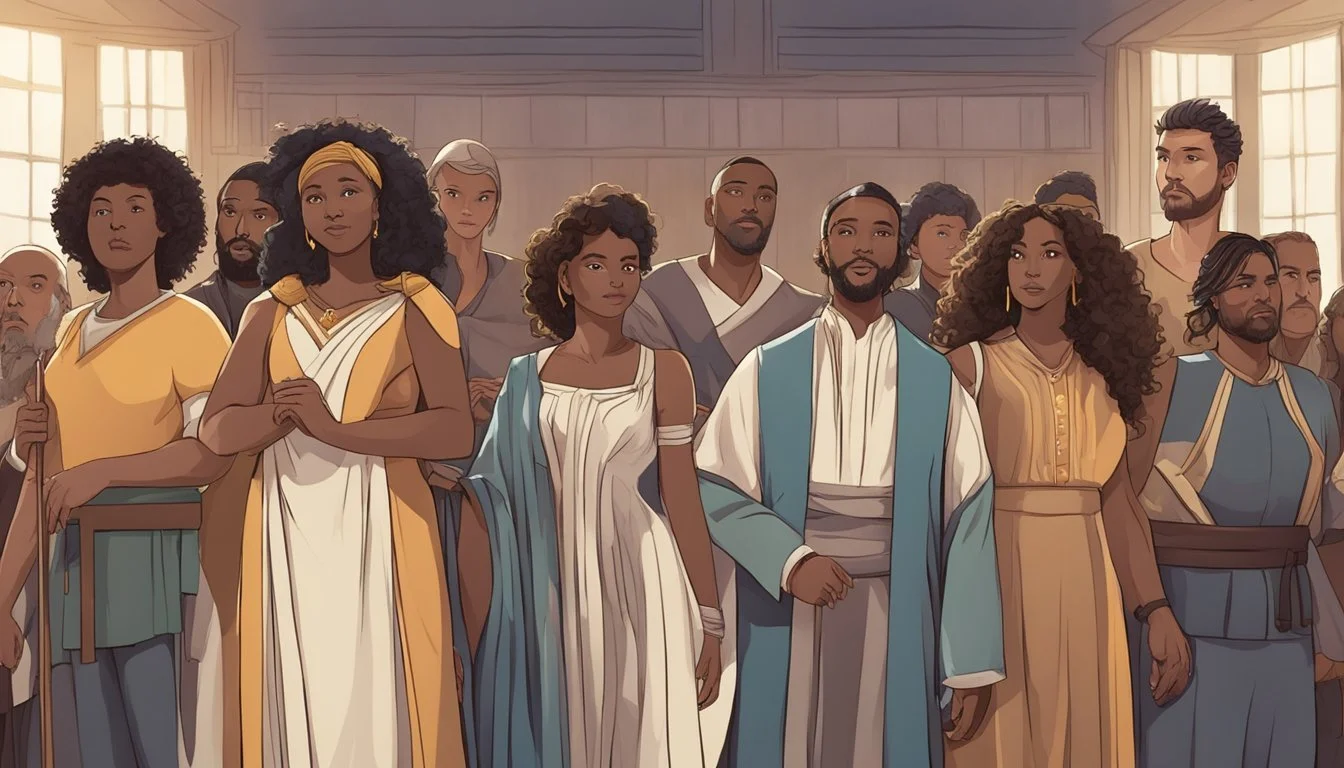The Supporting Cast of 'Testament'
Spotlight on Key Performances Elevates Biblical Epic
Testament, the 1983 drama film directed by Lynne Littman, offers a poignant exploration of human resilience in the face of nuclear catastrophe. While Jane Alexander and William Devane lead the cast as parents grappling with an unthinkable reality, the supporting performers bring depth and nuance to this haunting tale.
The strength of Testament lies in its ensemble cast, whose collective performances create a vivid portrait of a community unraveling. From neighbors to children, each character contributes to the film's powerful emotional impact, painting a stark picture of ordinary lives forever altered by extraordinary circumstances.
Testament's supporting actors skillfully portray the various ways individuals might react to societal collapse, ranging from despair to unexpected bravery. Their portrayals ground the film's high-stakes premise in relatable human experiences, allowing viewers to connect with the story on a deeply personal level.
Unveiling the Narrative
"Testament: The Story of Moses" presents a fresh take on the biblical tale, blending historical drama with spiritual themes. The series delves into Moses' journey from outcast to liberator, exploring the complexities of his character and the challenges he faced.
The Central Plot and Themes
The narrative follows Moses' transformation from an Egyptian prince to the leader of the Hebrew exodus. It explores themes of identity, faith, and leadership. The series portrays Moses' internal struggles as he grapples with his dual heritage and divine calling.
Key plot points include:
Moses' discovery of his Hebrew origins
His exile in Midian
The burning bush encounter
Confrontations with Pharaoh
The ten plagues
The exodus from Egypt
The parting of the Red Sea
These events are depicted with a focus on Moses' human qualities, showcasing his doubts, fears, and growth.
Adaptation Details
"Testament" adapts elements from biblical sources, including the Torah and the Book of Exodus. It also incorporates historical research to provide context for the ancient Egyptian setting.
The series takes creative liberties to:
Flesh out characters' motivations
Add dramatic tension to key scenes
Explore Moses' relationships with family and followers
Visual effects are used to bring miracles to life, balancing spectacle with character-driven storytelling. The adaptation aims to make the story accessible to modern audiences while respecting its religious significance.
Character Insights
The cast of "Testament" brings to life key biblical figures with depth and nuance. Each character portrays pivotal roles in Moses' journey, from his immediate family to his adversaries.
Moses: The Chosen Prophet
Charles Dance portrays Moses, the central figure of the series. His performance captures Moses' transformation from an Egyptian prince to the leader of the Israelites. Dance conveys Moses' internal struggles, doubts, and ultimate faith in God's plan.
Moses' character arc includes his exile, encounter with the burning bush, and return to Egypt. The series explores his relationship with God and the weight of his divine mission. Dance's portrayal highlights Moses' human side, showing his fears and hesitations alongside his strength and determination.
Aaron and Miriam: The Supportive Siblings
Aaron and Miriam play crucial roles as Moses' siblings and supporters. Aaron, portrayed by Russell Tovey, serves as Moses' spokesperson and right-hand man. The series explores Aaron's loyalty and occasional doubts.
Miriam, played by Nathalie Emmanuel, is depicted as a prophetess and leader in her own right. Her character showcases the importance of women in biblical narratives. The series delves into the siblings' dynamics, their shared faith, and their individual contributions to the Exodus story.
Zipporah and Bithiah: Family Ties
Zipporah, Moses' wife, is portrayed as a strong and supportive partner. The series explores their relationship and Zipporah's role in Moses' journey. Her character provides insight into Midianite culture and Moses' life during his exile.
Bithiah, Pharaoh's daughter who adopts Moses, is depicted as a complex character torn between her Egyptian upbringing and her love for Moses. Her scenes offer a unique perspective on Moses' early life in the royal court.
Pharaoh: The Imperial Antagonist
The Pharaoh, likely based on Ramses II, serves as the primary antagonist. The series portrays him as a multifaceted ruler, exploring his motivations and the impact of the plagues on Egypt. His interactions with Moses highlight the clash between divine will and human power.
The Pharaoh's character development includes his initial refusal to free the Israelites, his reactions to the plagues, and his ultimate decision to let them go. The series delves into the political and personal consequences of his choices.
Supporting Biblical Characters
"Testament" features several supporting characters who enrich the narrative:
Jethro, Moses' father-in-law, provides wisdom and guidance.
Jochebed, Moses' birth mother, is shown in flashbacks, emphasizing the risks she took to save her son.
Joshua, Moses' successor, is introduced as a young warrior who becomes a key follower.
These characters add depth to the story, offering different perspectives on faith, leadership, and the challenges faced by the Israelites during their journey to the Promised Land.
The Production Design
The production design of "Testament" masterfully blends historical accuracy with contemporary elements. Meticulous attention to detail creates an immersive visual experience that transports viewers to the time of the early church.
Recreating Historical Context
The production team collaborated with historians and theologians to ensure authenticity in the show's depiction of 1st century Judea and the Roman Empire. Costumes incorporate period-appropriate fabrics and styles, while still allowing for subtle modern touches to resonate with audiences. Props and set dressings are carefully curated to reflect the daily life and material culture of the era.
Religious artifacts and iconography are faithfully recreated based on archaeological evidence. The production design team also consulted experts on ancient languages to ensure accurate signage and written materials appear throughout the series.
Set Design and Locations
"Testament" utilizes a mix of on-location filming and purpose-built sets to bring its world to life. Key historical sites in Israel and Jordan serve as backdrops for exterior scenes, providing an authentic sense of place.
Elaborate soundstage sets recreate interiors of homes, synagogues, and Roman buildings. These designs incorporate architectural details and decorative elements typical of the period. The production employs cutting-edge visual effects to expand and enhance physical sets, seamlessly blending practical and digital elements.
Urban scenes depict bustling marketplaces and crowded streets, filled with extras in period costume. Rural locations showcase the diverse landscapes of the region, from arid deserts to lush Mediterranean coastlines.
The Cast and Their Performances
"Testament" features a talented ensemble of actors who bring depth and nuance to their roles. Their performances breathe life into the characters, creating a compelling narrative that resonates with audiences.
Principle Cast Profiles
Charles Dance leads the cast with his commanding presence as Professor Euan Rossi. His portrayal of the Oxford mathematician searching for his missing student is both intense and nuanced. Clarke Peters delivers a standout performance as Detective Inspector Perez, bringing gravitas and empathy to the role.
Mehmet Kurtulus impresses as the enigmatic Dr. Haluk Özgün, while Ishai Golan shines as the troubled archaeologist Dr. Avi Cohen. Tülay Günal captivates viewers with her portrayal of the mysterious Elif Kartal, adding layers of intrigue to the story.
Supporting Roles and Contributions
Melis Ulaş brings a youthful energy to the cast as Zeynep, a local student caught up in the unfolding events. Her performance adds a fresh perspective to the narrative. Oberon K.A. Adjepong delivers a memorable turn as Professor Samuel Osei, whose expertise proves crucial to the investigation.
Cem Emüler rounds out the supporting cast with his portrayal of Inspector Mehmet Yilmaz. His chemistry with Clarke Peters' Perez creates engaging on-screen dynamics. These supporting players enrich the story, providing essential context and depth to the main characters' journeys.
Cultural Representation
The supporting cast of 'Testament' played a crucial role in depicting the cultural and religious aspects of the biblical narrative. Their performances brought authenticity to the portrayal of ancient Israelite society and the emerging religious traditions.
Portraying Judaism and Christianity
The actors in 'Testament' faced the challenge of representing early Judaism and nascent Christianity. They depicted religious rituals, customs, and beliefs with care and attention to detail. The cast's performances highlighted the spiritual journey of the Israelites, from polytheistic influences to monotheism.
Key scenes showcased actors portraying priests, prophets, and common people practicing their faith. The exodus narrative featured depictions of Passover rituals and the receiving of the Ten Commandments. These portrayals helped viewers understand the foundations of Judaic traditions.
Historical Accuracy and Creative Liberties
The supporting cast balanced historical accuracy with creative interpretation. Actors wore period-appropriate costumes and used props that reflected ancient Near Eastern cultures. They incorporated gestures and mannerisms based on historical research to bring authenticity to their roles.
Some creative liberties were taken to make the story more relatable to modern audiences. The cast's performances included subtle nods to contemporary issues, drawing parallels between ancient and current societal challenges.
Divine intervention scenes required a delicate approach. Actors conveyed awe and reverence without relying on excessive special effects, allowing viewers to interpret miraculous events through the characters' reactions.
Audience Reception and Critique
"Testament" garnered significant attention from viewers and critics alike. The series sparked discussions among historians, theologians, and general audiences about its portrayal of Biblical events.
Critical Acclaim and Reviews
Critics praised the supporting cast's performances in "Testament." Many reviewers highlighted the depth and nuance brought to lesser-known Biblical figures. The series received high marks for its production values and attention to historical detail.
Netflix reported strong viewership numbers for "Testament" in its first month of release. The show's innovative approach to storytelling attracted both religious and secular audiences.
Public and Scholarly Reception
Historians and theologians engaged in lively debates about the series' historical accuracy. Some praised its efforts to humanize Biblical characters, while others criticized certain creative liberties taken with the source material.
"Testament" became a topic of discussion in religious studies courses at several universities. Scholars analyzed its impact on popular perceptions of Biblical narratives.
On social media, viewers shared their interpretations of key scenes and character arcs. Fan theories about the show's historical context gained traction online.
Marketing and Publicity
The marketing campaign for "Testament" focused on generating anticipation and buzz. Strategic promotional efforts aimed to highlight the film's key performances and draw audiences to theaters.
Trailers and Promotional Materials
The official trailer for "Testament" debuted online and in theaters three months before release. It showcased intense dramatic scenes featuring the main cast. Character posters spotlighted individual performances, building intrigue around the ensemble.
TV spots aired during prime time slots on major networks. These 30-second clips emphasized the film's emotional core and critical acclaim. Print ads in entertainment magazines featured striking imagery and pull quotes praising the acting.
Movie websites hosted exclusive behind-the-scenes content. This included cast interviews and featurettes on the film's production. Digital billboards in major cities displayed eye-catching artwork to capture attention.
Social Media Buzz and Advertising
The film's social media accounts shared regular updates to engage followers. Cast members participated in live Q&A sessions on platforms like Twitter and Instagram. These interactions allowed fans direct access to the actors, building excitement.
Targeted ads on Facebook and YouTube reached demographics likely to be interested in the film. Sponsored content on entertainment news sites provided in-depth looks at key performances. Influencer partnerships helped spread word-of-mouth recommendations to wider audiences.
A hashtag campaign encouraged viewers to share their reactions after watching. This user-generated content created organic buzz and personal endorsements. Paid promotion on streaming platforms placed "Testament" ads alongside similar content.
Impact and Legacy
"Testament" left a lasting impression on audiences and the film industry. Its unflinching portrayal of nuclear devastation and its aftermath resonated deeply, sparking important conversations.
Influence on Popular Culture
"Testament" challenged the typical disaster movie formula by focusing on the emotional toll rather than spectacle. This approach influenced later post-apocalyptic films and TV shows, encouraging more character-driven narratives. The film's haunting imagery, especially of children facing an uncertain future, became iconic.
Popular culture references to "Testament" appeared in music, literature, and other media. Its stark depiction of societal breakdown in the face of nuclear war served as a touchstone for artists exploring similar themes.
Educational Value
"Testament" became an important educational tool in schools and universities. It was used to teach about the potential consequences of nuclear warfare and the importance of disarmament efforts. The film's realistic portrayal of radiation sickness and societal collapse provided a sobering counterpoint to more sensationalized depictions.
Many peace organizations and anti-nuclear groups screened "Testament" to raise awareness. Its focus on a suburban American family made the threat of nuclear war feel immediate and personal to viewers who might have previously seen it as an abstract concept.









